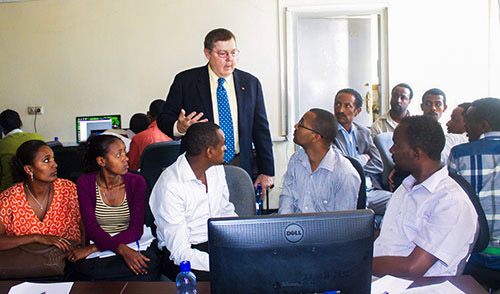 Sharing resources is one way to spread knowledge. Pathology Professor Peter Anderson, DVM, Ph.D., knows this. He also knows a grant awarded to him five years ago is making possible his work with medical schools in Zambia and elsewhere in Africa.
Sharing resources is one way to spread knowledge. Pathology Professor Peter Anderson, DVM, Ph.D., knows this. He also knows a grant awarded to him five years ago is making possible his work with medical schools in Zambia and elsewhere in Africa.“Without the grant, I wouldn’t have had the slides available to give to the Copperbelt University School of Medicine,” Anderson said. “It was a real circle-of-life moment.”
Anderson said he was contacted by Craig Wilson, M.D., director of the Sparkman Center for Global Health, about traveling to Zambia to learn what UAB could do for the University of Zambia School of Medicine. UAB has been conducting HIV-related research and patient care in Zambia for 20 years.
“I initially wanted to get involved because it sounded exciting to go to Africa; I had never been to the continent,” Anderson said. “Once I got over there and started working with the faculty, I was overwhelmed by how bad things were for the teaching faculty and students and how poor the health-care systems and facilities were.”
Medical education in Zambia
The ratio of doctors to patients in Zambia, a country with a population of 14 million, is 1:15,000. The University of Zambia School of Medicine, the only public medical school until 2011, has been training doctors for 45 years and has graduated more than 1,200 doctors. However, the high attrition rate of 40 percent and low annual graduation rate has been unable to keep pace with the population growth of about 1.8 percent.Anderson said UAB faculty who initially went to Zambia to conduct HIV research realized there were not enough trained health-care workers, and they began visiting the University of Zambia School of Medicine to find out what its faculty needed.
“Dr. Wilson and the Sparkman Center for Global Health were instrumental in developing the relationship with the health professions educators,” Anderson said.
In 2010, the National Institutes of Health announced the Medical Educational Partnership Initiative (MEPI), which will allocate $130 million to medical schools in sub-Sarahan African countries during a five-year period. The goal is to increase the number of health-care workers by 140,000.
The University of Zambia School of Medicine received some of that money, and in 2011 Kasonde Bowa, Ph.D., a faculty member, left to become dean of the newly opened Copperbelt University School of Medicine, also located in Zambia. Anderson and Wilson, who know Bowa, made a trip to see how they could help the new school.
Virtual microscopy
In 2009, Anderson had received a grant through the University of Alabama Health Services Foundation General Endowment Fund to buy a microscope slide scanner and fund a work-study student. After hours of scanning and culling slides from friends across the country, Anderson had thousands of images in his arsenal to use for teaching histology and histopathology. “Microscopes are expensive and they tend to break and need cleaning and/or repair and glass slides fade with time and/or break,” Anderson said. “So, virtual microscopy is a nice way to store and deliver histology slides for teaching using computers and hand-held digital devices.”
“Microscopes are expensive and they tend to break and need cleaning and/or repair and glass slides fade with time and/or break,” Anderson said. “So, virtual microscopy is a nice way to store and deliver histology slides for teaching using computers and hand-held digital devices.”When Anderson and Wilson visited Zambia’s new School of Medicine, they learned the school did not have microscopes or slides for teaching histology or histopathology. Anderson gave Bowa a 500 GB portable hard drive with thousands of slides he had available because of his grant.
“Bowa was able to use our UAB virtual microscope slide collection to teach the medical students that first year,” Anderson said. “We stayed in contact, and when I visited him several more times I brought additional slide files and teaching materials to help with his courses.”
Anderson said courses in histology and histopathology focus on the structure of the human body and how normal structures are altered or damaged during disease.
“If you know the normal structure and function of tissues, you can more easily understand how disease causes problems and you can better understand and appreciate treatment options and methods,” Anderson said. “Just about every health professional student, no matter the discipline, takes classes in structure and function of the body to help them better understand their patient’s ailments.”
Through MEPI the school was able to receive 15 laptops and loaded the virtual microscopy program onto all of them.
“Virtual microscopy fills a huge resource gap,” Wilson said. “The ability to teach histology and pathology without the need for microscopes also means saving space and lots of maintenance issues.”
Anderson’s assistance to Copperbelt University School of Medicine has been reported in “Academic Medicine,” the journal for the Association of American Medical Colleges.
“During the past three years, 112 medical and dental students have used virtual microscopy as their sole means to study histology,” according to the report. “More than three-quarters of staff and students reported in a self-administered questionnaire that virtual microscopy was an effective and efficient easy way to study histology.”
Since word spread, other institutions across the continent have asked Anderson to visit and bring the materials. Anderson has worked with more than 15 schools in five countries.
“I think the main thing UAB gets out of this is the positive image we have all over the world,” Anderson said. “Medical schools all over Africa wanted me to come show them how to use virtual microscopy, so I would like to think we have spread a lot of goodwill.”